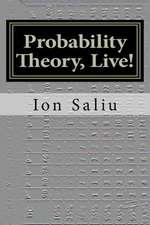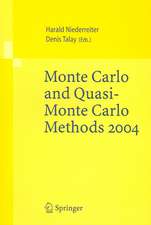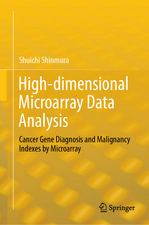New Theory of Discriminant Analysis After R. Fisher: Advanced Research by the Feature Selection Method for Microarray Data
Autor Shuichi Shinmuraen Limba Engleză Hardback – 6 ian 2017
We compared two statistical LDFs and six MP-based LDFs. Those were Fisher’s LDF, logistic regression, three SVMs, Revised IP-OLDF, and another two OLDFs. Only a hard-margin SVM (H-SVM) and Revised IP-OLDF could discriminate LSD theoretically (Problem 2). We solved the defect of the generalized inverse matrices (Problem 3).
For more than 10 years, many researchers have struggled to analyze the microarray dataset that is LSD (Problem 5). If we call the linearly separable model "Matroska," the dataset consists of numerous smaller Matroskas in it. We develop the Matroska feature selection method (Method 2). It finds the surprising structure of the dataset that is the disjoint union of several small Matroskas. Our theory and methods reveal new facts of gene analysis.
| Toate formatele și edițiile | Preț | Express |
|---|---|---|
| Paperback (1) | 637.13 lei 6-8 săpt. | |
| Springer Nature Singapore – 7 iul 2018 | 637.13 lei 6-8 săpt. | |
| Hardback (1) | 643.34 lei 6-8 săpt. | |
| Springer Nature Singapore – 6 ian 2017 | 643.34 lei 6-8 săpt. |
Preț: 643.34 lei
Preț vechi: 756.86 lei
-15% Nou
Puncte Express: 965
Preț estimativ în valută:
123.16€ • 126.73$ • 103.82£
123.16€ • 126.73$ • 103.82£
Carte tipărită la comandă
Livrare economică 01-15 martie
Preluare comenzi: 021 569.72.76
Specificații
ISBN-13: 9789811021633
ISBN-10: 9811021635
Pagini: 210
Ilustrații: XX, 208 p. 28 illus., 25 illus. in color.
Dimensiuni: 155 x 235 x 14 mm
Greutate: 0.5 kg
Ediția:1st ed. 2016
Editura: Springer Nature Singapore
Colecția Springer
Locul publicării:Singapore, Singapore
ISBN-10: 9811021635
Pagini: 210
Ilustrații: XX, 208 p. 28 illus., 25 illus. in color.
Dimensiuni: 155 x 235 x 14 mm
Greutate: 0.5 kg
Ediția:1st ed. 2016
Editura: Springer Nature Singapore
Colecția Springer
Locul publicării:Singapore, Singapore
Cuprins
1 New Theory of Discriminant Analysis.- 1.1 Introduction.- 1.2 Motivation for our Research.- 1.3 Discriminant Functions.- 1.4 Unresolved Problem (Problem 1).- 1.5 LSD Discrimination (Problem 2).- 1.6 Generalized Inverse Matrices (Problem 3).- 1.7 K-fold Cross-validation (Problem 4).- 1.8 Matroska Feature Selection Method (Problem 5) .- 1.9 Summary.- References.- 2 Iris Data and Fisher’s Assumption.- 2.1 Introduction.- 2.2 Iris Data.- 2.3 Comparison of Seven LDFs.- 2.4 100-folf Cross-validation for Small Sample Method (Method 1).- 2.5 Summary.- References.- 3 The Cephalo-Pelvic Disproportion (CPD) Data with Collinearity.- 3.1 Introduction.- 3.2 CPD Data.- 3.3 100-folf Cross-validation.- 3.4 Trial to Remove Collinearity.- 3.5 Summary.- References.- 4 Student Data and Problem 1.- 4.1 Introduction.- 4.2 Student Data.- 4.3 100-folf Cross-validation for Student Data.- 4.4 Student Linearly Separable Data.- 4.5 Summary.- References.- 5 The Pass/Fail Determination using Exam Scores -A Trivial Linear Discriminant Function.- 5.1 Introduction.- 5.2 Pass/Fail Determination by Exam Scores Data in 2012.- 5.3 Pass/Fail Determination by Exam Scores (50% Level in 2012).- 5.4 Pass/Fail Determination by Exam Scores (90% Level in 2012).- 5.5 Pass/Fail Determination by Exam Scores (10% Level in 2012).- 5.6 Summary.- 6 Best Model for the Swiss Banknote Data – Explanation 1 of Matroska Feature -selection Method (Method 2) -. References.- 6 Best Model for Swiss Banknote Data.- 6.1 Introduction.- 6.2 Swiss Banknote Data.- 6.3 100-folf Cross-validation for Small Sample Method.- 6.4 Explanation 1 for Swiss Banknote Data.- 6.5 Summary.- References.- 7 Japanese Automobile Data – Explanation 2 of Matroska Feature Selection Method (Method 2).- 7.1 Introduction.- 7.2 Japanese Automobile Data.- 7.3 100-folf Cross-validation (Method 1).- 7.4 Matroska Feature Selection Method (Method 2).- 7.5 Summary.- References.- 8 Matroska Feature Selection Method for Microarray Data (Method 2).- 8.1 Introduction.-8.2 Matroska Feature Selection Method (Method2).- 8.3 Results of the Golub et al. Dataset.- 8.4 How to Analyze the First BGS.- 8.5 Statistical Analysis of SM1.- 8.6 Summary.- References.- 9 LINGO Program 1 of Method 1.- 9.1 Introduction.- 9.2 Natural (Mathematical) Notation by LINGO.- 9.3 Iris Data in Excel.- 9.4 Six LDFs by LINGO.- 9.5 Discrimination of Iris Data by LINGO.- 9.6 How to Generate Re-sampling Samples and Prepare Data in Excel File.- 9.7 Set Model by LINGO.- Index.
Notă biografică
Shuichi Shinmura, Seikei University
Textul de pe ultima copertă
This is the first book to compare eight LDFs by different types of datasets, such as Fisher’s iris data, medical data with collinearities, Swiss banknote data that is a linearly separable data (LSD), student pass/fail determination using student attributes, 18 pass/fail determinations using exam scores, Japanese automobile data, and six microarray datasets (the datasets) that are LSD. We developed the 100-fold cross-validation for the small sample method (Method 1) instead of the LOO method. We proposed a simple model selection procedure to choose the best model having minimum M2 and Revised IP-OLDF based on MNM criterion was found to be better than other M2s in the above datasets.
We compared two statistical LDFs and six MP-based LDFs. Those were Fisher’s LDF, logistic regression, three SVMs, Revised IP-OLDF, and another two OLDFs. Only a hard-margin SVM (H-SVM) and Revised IP-OLDF could discriminate LSD theoretically (Problem 2). We solved the defect of the generalized inverse matrices (Problem 3).
For more than 10 years, many researchers have struggled to analyze the microarray dataset that is LSD (Problem 5). If we call the linearly separable model "Matroska," the dataset consists of numerous smaller Matroskas in it. We develop the Matroska feature selection method (Method 2). It finds the surprising structure of the dataset that is the disjoint union of several small Matroskas. Our theory and methods reveal new facts of gene analysis.
We compared two statistical LDFs and six MP-based LDFs. Those were Fisher’s LDF, logistic regression, three SVMs, Revised IP-OLDF, and another two OLDFs. Only a hard-margin SVM (H-SVM) and Revised IP-OLDF could discriminate LSD theoretically (Problem 2). We solved the defect of the generalized inverse matrices (Problem 3).
For more than 10 years, many researchers have struggled to analyze the microarray dataset that is LSD (Problem 5). If we call the linearly separable model "Matroska," the dataset consists of numerous smaller Matroskas in it. We develop the Matroska feature selection method (Method 2). It finds the surprising structure of the dataset that is the disjoint union of several small Matroskas. Our theory and methods reveal new facts of gene analysis.
Caracteristici
Compares eight LDFs by seven different kinds of data sets from the points of view of M2 and 95% CI of the coefficient Presents solutions for five serious problems of discriminant analysis and finds important facts of discriminant coefficient and error rate with a new method of discriminant analysis Makes feature selection naturally and reveals the structure of the microarray data by the Matroska feature selection method



























